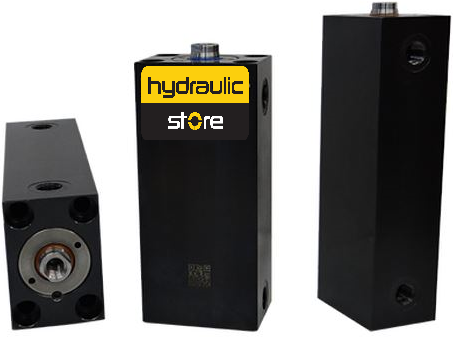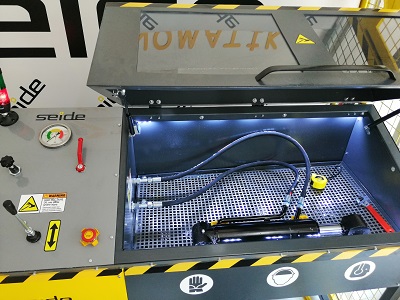


What is a Hydraulic Cylinder?
Hydraulic cylinders are mechanical actuators used to provide linear force and motion through the use of hydraulic fluid. They are commonly found in various industrial applications where heavy lifting or precise motion control is required. Here's a breakdown of how they work and some common uses:
Basic Principle: Hydraulic cylinders work on the principle of Pascal's law, which states that when pressure is applied to a confined fluid, it transmits that pressure equally in all directions. In a hydraulic cylinder, this pressure is used to create linear motion.
Components: A typical hydraulic cylinder consists of a cylindrical barrel, piston, piston rod, seals, and ports for hydraulic fluid. The piston divides the inside of the cylinder into two chambers: the "cap end" and the "rod end." Hydraulic fluid is pumped into one chamber while the other is allowed to exhaust, causing the piston to move linearly.
Operation: When hydraulic fluid is pumped into one end of the cylinder, it pushes against the piston, causing it to move in the desired direction. The force generated by the hydraulic pressure is proportional to the surface area of the piston and the pressure of the hydraulic fluid. This force can be calculated using the formula: Force = Pressure × Area.
Applications: Hydraulic cylinders are used in a wide range of applications, including construction equipment (such as excavators and bulldozers), manufacturing machinery (presses and injection molding machines), agricultural machinery (tractors and harvesters), aerospace and defense systems, automotive systems (brakes and steering), and many more.
Advantages: Hydraulic cylinders offer several advantages, including high force output in a compact design, precise control of motion and force, ability to operate in harsh environments (due to the use of hydraulic fluid instead of electric motors), and relatively low maintenance requirements.
Types: Hydraulic cylinders come in various types, including single-acting cylinders (which exert force in one direction and use a spring or external force to return to their original position) and double-acting cylinders (which exert force in both directions and use hydraulic fluid to extend and retract the piston).
Overall, hydraulic cylinders play a crucial role in many industries by providing efficient and reliable linear motion and force generation.
How does a hydraulic cylinder work?
A hydraulic cylinder operates based on the principles of fluid dynamics and pressure transmission. Here's a step-by-step explanation of how it works:
Basic Structure: A hydraulic cylinder consists of a cylindrical barrel, a piston, a piston rod, seals, and ports for hydraulic fluid.
Two Chambers: The inside of the cylinder is divided into two chambers by the piston: the "cap end" and the "rod end." The piston is a disc-shaped component that fits snugly inside the cylinder and can move back and forth.
Hydraulic Fluid: Hydraulic fluid, usually oil, is pumped into one chamber of the cylinder through a port. This pressurizes the fluid in that chamber.
Pressure Transmission: According to Pascal's law, pressure applied to a fluid in a confined space is transmitted undiminished in all directions. So, the pressurized fluid applies force evenly on the piston surface.
Piston Movement: The force exerted by the pressurized fluid on the piston causes it to move linearly within the cylinder. The direction of movement depends on which chamber the fluid is pumped into.
Work Output: The linear motion of the piston's rod can be harnessed to perform work. For example, if the piston is attached to a load, the movement of the piston rod can lift or move that load.
Fluid Transfer: As the piston moves, it displaces hydraulic fluid from one chamber to the other. The fluid in the opposite chamber is allowed to flow out through another port.
Control: The flow of hydraulic fluid into and out of the cylinder is controlled by valves, which regulate the direction, pressure, and speed of movement. This allows for precise control of the cylinder's motion.
Return Stroke: In a double-acting hydraulic cylinder, hydraulic fluid can be pumped into either end of the cylinder to extend or retract the piston. When fluid is pumped into the opposite end, the piston moves in the opposite direction.
Sealing: Seals are essential components of hydraulic cylinders, preventing leakage of hydraulic fluid and maintaining the integrity of the system.
Overall, hydraulic cylinders provide efficient and powerful linear motion by utilizing the pressure of hydraulic fluid to move a piston within a cylinder. They are widely used in various industrial applications due to their reliability, versatility, and ability to generate high forces.

Hydraulic Cylinder Features
»Mounting dimensions and mounting types comply with World standards.
»12 standard mounting types.
»Piston diameter: 40 mm - 800 mm
»Piston rod diameter: 22 mm - 600 mm
»Stroke length up to 6000 mm
Specifications Standards:
Mounting dimensions and mounting types meet the World standard. The piston diameter and piston rod diameter conform to the ISO 3320 standard The test standard is ISO 10100.
Nominal Pressure: 350 Bar (35 MPa)
Test Pressure: 500 Bar (50 MPa)
Optionally, it can be produced with 700 bar (70 MPa) working pressure.
Fluid Type: Mineral oils DIN 51524 HL, HLP.
Liquid Temperature: -20 ° C to +80 ° C
Operating Temperature: -20 ° C to +80 ° C.
Optionally, it can be produced with an operating temperature between -30 ° C and +200 ° C.
Viscosity: 5 cSt - 300 cSt
Piston Speed: Maximum 0.5 m / s.
Cleaning class according to ISO Standard The maximum level of pollution of the hydraulic fluid is ISO 4406 (c) class 20/18/15. Cleaning classes specified for the components in the hydraulic system must be provided. Effective filtering prevents errors and extends component life.
Application Requirements:
»Movement axes and connection points of hydraulic cylinder and piston rod must be mechanically aligned. Lateral loads to the piston rod and piston bearings should be avoided. The weight of the hydraulic cylinder or piston rod must be taken into account.
»Buckling length and buckling load of the piston rod and / or hydraulic cylinder must be taken into consideration.
»Compatibility of sealing elements with liquid must be taken into account at maximum piston speed.
»The maximum working pressure must be observed every time the hydraulic cylinder is operated.
»Negative effects such as aggressive fine particles, vapors, high temperature and compressed air pollution should be avoided.
Manufacturing Materials:
The cylinder pipe is made of honed St52Bk + S material. The piston rod is made of Ck45 material with a surface coated with at least 20 µm hard chrome at f7 tolerance.
Scale:
Each cylinder is subjected to internal and external leak test according to the Prepared Ppap File before delivery and in accordance with Hidroman standards and ISO 10100 standards.
Warranty and Service:
Hydraulic cylinders in Hidroman Production are under the warranty of our company for 2 years. In addition, service and spare parts support is provided for 10 years. User-induced errors and errors due to improper working conditions are out of warranty.
Service and repair activities are carried out by Hidroman personnel. In case of any damage that may occur during the assembly of the product to the system and product interventions made by people other than Hidroman personnel for repair and maintenance purposes, the product warranty is canceled.
You can contact us for all kinds of specially designed cylinder demands.
Moulder Rollers Block Rollers
10 separate body structures, connection options.
For the mold and fixture sectors;
Nominal pressure: 250 bar
Test pressure: 300 bar
Max. stroke: 200 mm
Piston Ø: 16 - 100 mm

Screw Fixture Rollers
Hydraulic fixture equipment subtab; Finger Cylinders, Rotary Cylinders, Hydraulic Supports
Screw Cylinders.
They are hydraulic cylinders that can be screwed directly to the fixture body.
There are printing and drawing versions.
Single effect, spring return.
Hydraulic Rotary Actuator Cylinders
8 different piston size options and torque values up to 6750 Nm
These are the cylinders designed according to customer needs and their rotation angles are determined.
Maximum working pressure up to 120 bar with its compact dimensions.

Uygulamaya Özel Çözümler
Yüksek Kaliteli Üretim
Üretim Aşamaları






Our industrial hydraulic cylinders are built to work in the toughest conditions. Developing solutions in partnership with our customers has allowed us to continually create and expand our portfolio of hydraulic cylinders that meet global safety standards for any environment you work in.Hidroman has rendered hydraulics even more capable, from mill-type to tie rod hydraulic cylinders; we have your hydraulic cylinder for safe and reliable lifting. This gives you smarter, reliable cost-optimized solutions with an extended lifecycle and intelligent components.
Mill type hydraulic cylinders are reliable drive elements and particularly suitable for use under extreme working conditions. General mechanical engineering, rolling mills and smelting works, presses, cranes, steel construction for hydraulic engineering or shipbuilding are typical fields of application. The Hidroman mill type hydraulic cylinder range comprises both, screwed and welded cylinders. In which welded cylinders distinguish themselves by their short, compact design. They have been tested and examined for up to 2 million load cycles.




